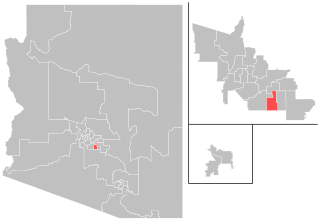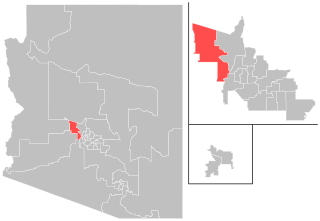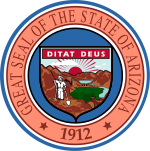
The New Jersey Redistricting Commission is a constitutional body of the government of New Jersey tasked with redrawing the state's Congressional election districts after each decade's census. Like Arizona, Idaho, Hawaii, Montana, and Washington; the redistricting is completed within an independent, bipartisan commission. The apportionment of members of the Redistricting Commission is carefully balanced between legislative and executive majorities and is purposefully designed to allow the minority party an equal number of seats on the commission. This commission deals with districts for the U.S. House of Representatives while the New Jersey Apportionment Commission deals with legislative districts for the New Jersey Legislature.
The California Citizens Redistricting Commission is the redistricting commission for the State of California responsible for determining the boundaries of districts for the State Senate, State Assembly, and Board of Equalization. The commission was created in 2010 and consists of 14 members: five Democrats, five Republicans, and four from neither major party. The commission was created following the passage in November 2008 of California Proposition 11, the Voters First Act. The commissioners were selected in November and December 2010 and were required to complete the new maps by August 15, 2011.

The 2020 United States redistricting cycle is in progress following the completion of the 2020 United States census. In all fifty states, various bodies are re-drawing state legislative districts. States that are apportioned more than one seat in the United States House of Representatives are also drawing new districts for that legislative body.

Arizona's 2nd legislative district is one of 30 in the state, consisting of a section of Maricopa County. As of 2023, there are 48 precincts in the district, all in Maricopa, with a total registered voter population of 131,648. The district has an overall population of 246,674.

Arizona's 3rd legislative district is one of 30 in the state, consisting of a section of Maricopa County. As of 2023, there are 58 precincts in the district, all in Maricopa, with a total registered voter population of 175,721. The district has an overall population of 236,955.

Arizona's 10th legislative district is one of 30 in the state, consisting of sections of Maricopa County and Pinal County. As of 2023, there are 46 precincts in the district, 43 in Maricopa and three in Pinal, with a total registered voter population of 142,562. The district has an overall population of 235,579.

Arizona's 11th legislative district is one of 30 in the state, consisting of a section of Maricopa County. As of 2023, there are 37 precincts in the district, all in Maricopa, with a total registered voter population of 109,103. The district has an overall population of 237,844.

Arizona's 13th legislative district is one of 30 in the state, consisting of a section of Maricopa County. As of 2023, there are 45 precincts in the district, all in Maricopa, with a total registered voter population of 141,334. The district has an overall population of 237,866.

Arizona's 15th legislative district is one of 30 in the state, consisting of sections of Maricopa County and Pinal County. As of 2023, there are 45 precincts in the district, 26 in Maricopa and 19 in Pinal, with a total registered voter population of 154,450. The district has an overall population of 240,028.

Arizona's 16th legislative district is one of 30 in the state, consisting of sections of Maricopa County, Pima County, and Pinal County. As of 2023, there are 72 precincts in the district, two in Maricopa, 17 in Pima, and 53 in Pinal, with a total registered voter population of 138,464. The district has an overall population of 236,940.

Arizona's 17th legislative district is one of 30 in the state, consisting of sections of Pima County and Pinal County. As of 2023, there are 68 precincts in the district, 63 in Pima and five in Pinal, with a total registered voter population of 175,483. The district has an overall population of 239,669.

Arizona's 18th legislative district is one of 30 in the state, consisting of a section of Pima County. As of 2023, there are 65 precincts in the district, all in Pima, with a total registered voter population of 162,116. The district has an overall population of 243,411.

Arizona's 19th legislative district is one of 30 in the state, consisting of all of Greenlee County and sections of Cochise County, Graham County, Pima County, and Santa Cruz County. As of 2023, there are 96 precincts in the district, with a total registered voter population of 146,048. The district has an overall population of 230,476.

Arizona's 23rd legislative district is one of 30 in the state, consisting of sections of Maricopa County, Pima County, Pinal County, and Yuma County. As of 2023, there are 65 precincts in the district, with a total registered voter population of 121,771. The district has an overall population of 232,246.

Arizona's 27th legislative district is one of 30 in the state, consisting of a section of Maricopa County. As of 2023, there are 51 precincts in the district, all in Maricopa, with a total registered voter population of 136,164. The district has an overall population of 240,634.

Arizona's 28th legislative district is one of 30 in the state, consisting of a section of Maricopa County. As of 2023, there are 59 precincts in the district, all in Maricopa, with a total registered voter population of 158,777. The district has an overall population of 228,803.

Arizona's 29th legislative district is one of 30 in the state, consisting of a section of Maricopa County. As of 2023, there are 47 precincts in the district, all in Maricopa, with a total registered voter population of 142,701. The district has an overall population of 240,102.

Arizona's 30th legislative district is one of 30 in the state, consisting of all of La Paz County and sections of Maricopa County, Mohave County, and Yavapai County. As of 2023, there are 38 precincts in the district, with a total registered voter population of 157,848. The district has an overall population of 237,999.

Redistricting in Wisconsin is the process by which boundaries are redrawn for municipal wards, Wisconsin State Assembly districts, Wisconsin State Senate districts, and Wisconsin's congressional districts. Redistricting typically occurs—as in other U.S. states—once every decade, usually in the year after the decennial United States census. According to the Wisconsin Constitution, redistricting in Wisconsin follows the regular legislative process, it must be passed by both houses of the Wisconsin Legislature and signed by the Governor of Wisconsin—unless the Legislature has sufficient votes to override a gubernatorial veto. Due to political gridlock, however, it has become common for Wisconsin redistricting to be conducted by courts. The 1982, 1992, and 2002 legislative maps were each enacted by panels of United States federal judges; the 1964 and 2022 maps were enacted by the Wisconsin Supreme Court.
Smiley v. Holm, 285 U.S. 355 (1932), was a decision of the Supreme Court of the United States involving a governor's power to veto a congressional redistricting proposal passed by a state's legislature. In an opinion by Chief Justice Charles Evans Hughes, the Court unanimously held that the U.S. Constitution did not prohibit Minnesota's governor from vetoing that state's redistricting map.



















